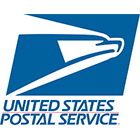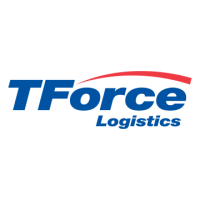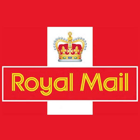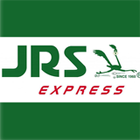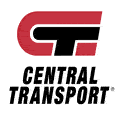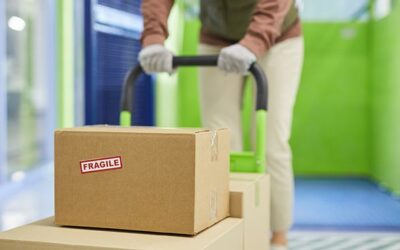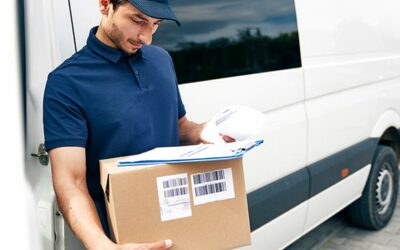We’ll Help You Track and Trace Your Parcel
Track Trace My Parcel
Package tracking, often called “package logging,” is the modern solution to ensuring shipments, be they in containers, traditional mail, or parcels, are vigilantly monitored from their point of origin through their journey in sortation and storage until the final delivery.
The history of shipment monitoring is rich, serving customers with invaluable insights into their parcel’s trajectory and precise delivery expectations. With packages historically managed by many couriers under diverse weather conditions, the potential for a parcel’s misadventure was notably high.
Our website, “Track Trace My Parcel,” streamlines this process, offering a user-friendly interface to oversee your shipment’s progress. Collaborating with regional shipping partners and global post/EMS entities, our platform encompasses an expansive network of international courier services.
Popular Tracking Companies
Latest Blog Articles
EC Best Service Reviews: Your Ultimate Guide
Last Updated: Oct 8, 2023When looking for exceptional services, whether in e-commerce, digital marketing, or any other...
EC Best Service Lost Package: A Comprehensive Guide
Date Published: Sep 23, 2023 - Last Updated: Sep 23, 2023Misplacing a package is every online shopper's nightmare....
EC Best Service Shipping Times: A Comprehensive Guide
Date Published: Sep 20, 2023 - Last Updated: Sep 20, 2023Understanding shipping times is crucial in a world where...
EC Best Service vs USPS: A Comprehensive Comparison
Date Published: September 20, 2023 - Last Updated: September 20, 2023Navigating the world of mail and parcel delivery...
USPS Tracking Accuracy: An In-depth Look
Last Updated: August 23, 2023The United States Postal Service (USPS) has been integral to America's communication and...
How to Change the Destination on UPS Tracking
Last Updated: August 23, 2023With the surge in online shopping, reliable package delivery has become integral to our...
How Logistic Companies Work
Navigating international shipping involves understanding physical and documentary processes.
To ensure a seamless flow of goods from the sender to the recipient, there are seven pivotal stages to be aware of. Each of these steps comes with its own associated costs, borne typically by either the sender or the recipient.
For a transparent, cost-effective, and timely supply chain, it’s crucial to pre-establish who foots the bill for each stage every time a shipment is booked.
The seven integral steps in international shipping are:
- Export Transport
- Origin Handling
- Export Customs Clearance
- Ocean Freight
- Import Customs Clearance
- Destination Handling
- Transport to Import.
Seven Phases of Global Shipping
For clarity regarding responsibilities and costs, always refer to the agreement between the sender and the recipient.
In transactions involving the sale of goods, the contract typically outlines the transfer of responsibility for the items. This document is crucial in determining who bears the costs and for which specific stages.
1. Export Transport
Export transport is where goods are transported from the seller’s location (such as a warehouse, factory, or farm) to the point of origin (like a seaport, airport, or railway station) from where they will be shipped internationally.
Modes of Transportation: Depending on the distance and the nature of the goods, various modes of transportation can be employed during this phase. This might include:
- Trucks
- Railways
- Smaller vessels for short-sea shipping
- Inland waterways, such as rivers or canals
Packaging and Handling: Before the goods are transported, they must be securely packaged to ensure they aren’t damaged during transit. This may require unique packaging materials or techniques, especially if the goods are fragile or perishable.
Documentation: At this stage, relevant documentation for the transportation of goods is often prepared and verified. This could potentially involve the following:
- A bill of lading (for sea freight) or airway bill (for air freight)
- Packing list
- A commercial invoice
- Other necessary permits or certifications, depending on the nature of the goods
Regulatory Compliance: The goods might need to comply with specific domestic regulations before they’re transported. For instance, hazardous materials might have specific transportation requirements or restrictions.
Cost Factors: Costs during the export transport phase can vary based on factors like:
- Distance from the seller’s location to the point of origin
- Mode of transportation chosen
- Special requirements for packaging or handling
Risks and Insurance: There are inherent risks involved in transporting goods, such as damage, theft, or delays. Therefore, many sellers seek insurance coverage for this phase to protect against potential losses.
Export transport is a foundational step in the international shipping process. Properly managing this phase ensures that goods reach their point of origin safely, on time, and in compliance with all relevant regulations.
This smooth transition sets the tone for the subsequent shipping stages, leading to successful and timely deliveries to global destinations.
2. Origin Handling Procedures
Origin handling involves a series of processes that begin from the moment goods are received at the shipping facility until they are loaded onto the mode of transport designated for international shipment, such as a ship, plane, or train.
Reception of Goods: Once goods arrive at the designated origin facility (like a port, airport, or rail terminal), they undergo a reception process. This typically includes:
- Verifying the goods against shipping documentation.
- Inspecting the physical condition of the cargo.
- Checking for required labels, markings, and packaging conditions.
Storage: After reception, the goods may be stored temporarily in warehouses or storage areas while awaiting further processing or consolidation with other shipments.
Consolidation and Containerization: Individual consignments might be grouped for efficient transportation depending on the shipping arrangement. Goods are often loaded into containers which come in various sizes, suitable for the type of goods and the chosen mode of transport.
Documentation: Proper documentation is crucial at this stage. Staff will ensure that all necessary documents are for the next steps, including:
- Export declaration
- Bills of lading or airway bills
- Special permits or certificates, if applicable
Inspections: Some goods may undergo additional checks by customs or other regulatory authorities to ensure compliance with export regulations.
Loading: Once everything is in order, the goods are loaded onto the chosen mode of transport, be it a ship, aircraft, or train. Special equipment, such as cranes or forklifts, may handle heavy or oversized cargo.
Safety and Security Measures: Safety is paramount. Goods are often subjected to security screenings, and measures are implemented to prevent theft, damage, or unauthorized access.
Cost Factors: Origin handling procedures come with associated costs, which can vary based on factors like:
- Duration of storage
- Type of goods and special handling requirements
- Necessary inspections or certifications
Origin handling procedures ensure that goods are efficiently and safely prepared for their international journey. Proper management of this phase is crucial as it directly impacts the success and timeliness of the entire shipping process.
The more streamlined and thorough these procedures, the smoother the subsequent shipping phases will likely be.
3. Managing Export Customs Clearance
Export customs clearance refers to the processes wherein the goods intended for export are declared to the customs authorities, and the necessary permissions are obtained to allow their exit from the country of origin.
Documentation: Proper documentation is at the heart of this process. Commonly required documents include:
Export Declaration: This document is mandatory in most countries, providing details about the goods, their value, destination, and other specifics.
- Commercial Invoice: Lists the details of the goods and the terms of the sale.
- Packing List: Describes the exported goods’ nature, quantity, and packaging.
- Certificates of Origin: Proves the origin of the goods.
- Special Permits: Depending on the nature of the goods (e.g., hazardous materials, rare animals, cultural artifacts), additional permits might be required.
Inspections: Before clearance, customs authorities may inspect the shipment to:
-
- Verify the accuracy of the documentation.
- Ensure that no prohibited or restricted items are included.
- Confirm the valuation of the goods for duty calculation, if applicable.
Duties and Taxes: Although this is primarily associated with imports, certain countries may have export duties or taxes that must be settled before goods can be exported.
Electronic Data Interchange (EDI): Many customs authorities have modernized their systems, allowing for the electronic submission of documents and data expediting the clearance process.
Regulatory Compliance: Different countries have various regulations regarding exports. It’s crucial to be aware of and comply with all export regulations and restrictions of the originating country.
Rejections and Delays: If the documentation needs to be corrected or completed, or if there are other compliance issues, the customs clearance process can be delayed, or the shipment can be rejected altogether.
Cost Factors: Managing export customs clearance might incur fees. These can include:
-
- Customs broker fees: Many shippers use customs brokers to navigate the complexities of export customs clearance.
- Fines or penalties for non-compliance or incorrect documentation.
- Export duties or taxes, where applicable.
Managing export customs clearance is vital in ensuring that goods cross international borders legally and efficiently. A successful clearance process ensures that goods are not subjected to unnecessary delays, fines, or rejections.
Familiarizing oneself with the regulations of the exporting country and ensuring all documentation is correct and complete is critical to a smooth and timely clearance process.
4. Ocean Freight
Ocean freight is shipping goods in containers or bulk via sea routes using cargo ships or specialized vessels from one port to another across different countries and continents.
Types of Ocean Freight:
- Containerized Shipping: Goods are packed in containers in various standard sizes, the most common being 20-foot and 40-foot variants. This method suits a wide range of commodities, from electronics to apparel.
- Bulk Shipping: Used for products like grains, coal, or oil, transported in large volumes without needing individual containers.
- Break Bulk Shipping: For goods not containerized but individually loaded onto the ship, like machinery or timber.
- Roll-on/Roll-off (RoRo) Shipping: Specifically designed for vehicles, where they can be driven onto the vessel and driven off at the destination.
Booking and Scheduling: Shippers book space on cargo vessels through shipping lines or freight forwarders, choosing a suitable schedule based on their shipping and delivery requirements.
Rates and Costs: Several factors determine the cost of ocean freight, including:
- The type of cargo.
- The volume or weight of the shipment.
- The route and distance between the ports of loading and discharge.
- Seasonal demand and shipping line rates.
Documentation: Crucial to ocean freight is the proper documentation, with the Bill of Lading (BoL) being the most vital. It serves as a receipt for the cargo, a title of the goods, and outlines the delivery terms.
Transit Time: Ocean freight often has longer transit times than air freight, varying from several days to weeks, depending on the distance and the specific sea routes.
Safety and Security: Modern cargo ships have safety measures to handle rough seas and adverse conditions. Additionally, security protocols are in place at major ports to prevent theft, piracy, and contraband.
Environmental Considerations: The shipping industry is continuously working on sustainable practices to reduce emissions, ballast water discharge, and other ecological impacts of ocean freight.
Intermodal Transportation: Ocean freight often works with other transportation modes, such as rail or truck, to offer door-to-door delivery. This integrated logistics approach is known as intermodal transportation.
Undertaking ocean freight is a complex yet reliable method for international trade and commerce. Given its cost-effectiveness and capacity to handle massive volumes, it’s a preferred choice for many businesses.
However, shippers must consider various logistical, regulatory, and environmental aspects of ocean shipping to ensure smooth sailing.
5. Import Customs Clearance
Import customs clearance is when customs authorities verify, inspect, and approve imported goods before they can legally enter the destination country.
Documentation: Proper documentation is crucial for this phase. Commonly required documents include:
- Bill of Lading (BoL) or Airway Bill: Confirms cargo receipt for shipment.
- Commercial Invoice: Details the goods being imported and their respective values.
- Packing List: Describes the quantity, weight, and type of goods.
- Certificate of Origin: Verifies the source country of the goods.
- Import License or Permit: An import license may be required in some countries or for specific products.
Duties and Taxes: Upon successful verification, customs duties and taxes are calculated based on the shipment’s value and product type. These fees need to be settled before the goods are released.
Inspections: Customs officials may inspect shipments to:
- Ensure the accuracy of provided information and documentation.
- Confirm that the goods aren’t prohibited or restricted.
- Validate the declared shipment value for accurate duty/tax calculation.
Regulatory Compliance: Each country has its regulations and restrictions on imports. This might include quotas, product standards, and certifications. Ensuring all goods comply with the destination country’s import regulations is essential.
Customs Brokerage: Given the complexity of customs clearance, many importers use the services of customs brokers. These professionals are well-versed in the local rules and procedures and can facilitate a smoother and faster clearance process.
Potential Challenges:
- Delays: Inaccurate or incomplete documentation or non-compliance with import regulations can lead to significant delays.
- Additional Costs: Fines or penalties for incorrect documentation or non-compliance might be imposed.
- Seizure of Goods: In extreme cases, if goods are deemed illegal or non-compliant, they might be confiscated by customs authorities.
Release of Goods: Once the inspection is complete, duties and taxes are paid, and all documentation is verified, the goods are cleared by customs. They can then be released to the importer or designated agent for further distribution or sale.
Import customs clearance plays a pivotal role in the international shipping journey, acting as the gatekeeper for goods entering a new country. A thorough understanding of the destination country’s customs procedures, regulations, and documentation requirements is essential to ensure a swift and hassle-free clearance process.
Proper planning and enlisting the expertise of customs brokers can mitigate risks and enhance the efficiency of the import process.
6. Destination Handling
Destination handling encompasses a series of actions and procedures at the receiving end of a shipment’s journey. It begins when the goods arrive at the destination port or terminal and continues until they are ready for pickup or further transport.
Unloading from the Vessel: The first step is to safely unload the cargo once the ship or aircraft arrives at its destination. This requires specialized equipment like cranes, forklifts, or conveyors, especially for large or heavy goods.
Inspection and Verification: As the goods are unloaded, they are typically inspected for any visible damage or discrepancies. This initial check helps identify potential issues that might have occurred during transit.
Temporary Storage: Post-unloading, the goods might be stored temporarily in warehouses or designated areas at the port or terminal. This allows time for customs clearance, documentation checks, or other required procedures.
Document Verification: Before the goods are released, relevant documents, such as the Bill of Lading (BoL) or Airway Bill, are verified to ensure the proper consignee or agent receives the cargo.
Customs Release: After the customs clearance, where goods are inspected and any necessary duties or taxes are paid, the customs authority will release the goods for further transportation or collection.
Deconsolidation: If the goods were consolidated with other shipments for transportation, they would need to be separated or deconsolidated at the destination.
Final Preparation: Depending on the nature of the goods and the requirements of the consignee, certain final handling steps might be necessary. This could include repackaging, labeling, or even some basic assembly.
Notification: Once everything is in order, the consignee or their designated agent is usually notified that the goods are ready for pickup or delivery.
Delivery to Final Destination: If the service includes door-to-door delivery, the shipment will be transported to the final destination, a warehouse, store, or end consumer.
Cost Factors: Destination handling can have associated costs, influenced by factors such as:
- Storage duration.
- Special handling requirements due to the nature of the goods.
- Additional services like repackaging or labeling.
Destination handling ensures that goods are appropriately managed and processed once they reach their destination country. It acts as a bridge between the arrival at the port and the final delivery or collection.
Effective destination handling is vital for the timely and efficient handover of shipments, and it plays a significant role in determining the overall satisfaction of the consignee.
7. Transport to Import
“Transport to Import” entails all logistical operations that get the goods from the destination port or terminal to the importer’s specified delivery point, be it a warehouse, distribution center, retail outlet, or even directly to an end consumer.
Modes of Transportation: Depending on the destination’s geography, distance from the port, and the nature of the goods, various transportation modes may be employed:
-
- Trucks: Ideal for door-to-door delivery and areas not accessible by other ways.
- Rail: Efficient for long distances and large quantities, especially in countries with extensive rail networks.
- Inland waterways: Using barges or smaller vessels, this mode is suitable for countries with navigable rivers or canals.
Final Documentation: As the goods are transported, the carrier usually provides documentation that proves the delivery. This could be a delivery receipt or a proof of delivery confirming the goods have reached their final destination.
Intermodal Transportation: Often, more than one mode of transport is used to get the goods to their final location.
For instance, a shipment might be transported by rail to a certain point and then switched to a truck for the remaining journey. Such integrated transportation is known as intermodal transportation.
Safety and Security: During this phase, ensuring the security and safety of goods is paramount. This might include tracking and monitoring systems, secure cargo seals, and specialized fragile or valuable items handling.
Regulations and Compliance: Transport within the importing country may have its rules, especially for specific categories of goods. For instance, transporting hazardous materials may require specific licenses or adherence to certain safety protocols.
Delivery Scheduling: Timely delivery is crucial, especially for perishable or time-sensitive items. Thus, scheduling, route optimization, and communication with the recipient become essential components.
Cost Factors: The cost of transport to import can vary based on:
-
- Distance to the final destination.
- The chosen mode of transport.
- Special handling or delivery requirements.
- Toll or usage fees for specific infrastructures, like highways or tunnels.
Potential Challenges:
- Last-mile delivery: The final stretch of the delivery, known as the “last mile,” can often be the most challenging and expensive, especially in congested urban areas.
- Delays: Traffic congestion, customs inspections, or adverse weather conditions can cause delays.
The “Transport to Import” phase is the concluding step in the international shipping journey, ensuring the goods reach the hands of the intended recipient.
Efficient management of this stage is essential for the satisfaction of the importer, and it often requires meticulous planning, coordination, and monitoring to ensure timely and safe delivery.
Effortlessly Monitor Your Shipment with Track Trace My Parcel
Navigating the intricate web of global logistics can be daunting. That’s where “Track Trace My Parcel” steps in. Designed for simplicity and efficiency, our platform consolidates shipment details from multiple carriers into one comprehensive tracking tool.
Here’s How It Works:
Universal Access: Whether you’re expecting a package via DHL, FedEx, UPS, or any other major carrier, our platform integrates their data, offering you a one-stop tracking solution.
Simple Tracking Process: Begin by entering your unique parcel tracking number into the designated space. One click on ‘track’, and you’re on your way.
Real-time Updates: Our system continuously updates to provide you with the most current status of your shipment. You’ll know instantly whether it’s just left the warehouse, is in transit, or has reached its final destination.
Additional Features: Beyond tracking, you can find estimated delivery dates, information about any delays, and insights into the route your parcel is taking.
By bringing all these features under one roof, “Track Trace My Parcel” takes the guesswork out of parcel tracking, ensuring you’re always in the loop about your shipment’s whereabouts.
FAQs on Parcel Tracking
Q: How Can I Easily Track My Parcel?
A: Tracking a parcel is straightforward with major carriers like UPS, FedEx, USPS, and DHL. Upon shipment, you’ll receive a tracking number via email or text. This number is key for tracking; find it in the email, on your receipt, or in your account with the shipping company.
Q: Where Do I Find My Parcel Tracking Number?
A: Your tracking number is typically sent via email or found in your account with the shipping company. For easy access, log onto the company’s website and enter your email to retrieve a list of your tracking numbers.
Q: What Exactly Is a Courier Tracking Number?
A: A tracking number is a unique alphanumeric code provided by courier services. It allows you to track your parcel’s journey online or by phone, offering details like location, delivery status, and more.
Q: Can I Track My Package in Real-Time?
A: Real-time tracking is available with certain courier services and specific shipping options. For instance, USPS’s Priority Mail Express and FedEx’s Priority Overnight services offer real-time tracking features.
Q: Why Am I Unable to Track My Parcel?
A: Inability to track a parcel may be due to it being sent via regular, non-trackable service, or it’s a new shipment not yet processed. Packages older than five days might also be untrackable if sent as regular mail.
Q: How Do I Track a Parcel from the Post Office?
A: To track a post office parcel, you need the tracking or customs number for international parcels. Enter this number on the respective postal service’s website to track your package.
Q: Is Calling the Post Office Effective for Package Tracking?
A: While you can call the post office to check on a package, online tracking or contacting the courier directly often provides more precise information. The post office can confirm basic status like ‘at the counter’ or ‘delivered,’ but for detailed updates, use online tools.
Q: Can an Order Number Track My Package?
A: Tracking a package with an order number varies by company. Some require an email address, others an order number. Check the company’s website for specific tracking instructions.
Q: Where to Find the Tracking Number on a Receipt?
A: The tracking number is typically located in the top corner of your receipt. It’s a unique combination of 9 or 10 digits and letters, essential for tracking your package.
Q: What Should I Do if My Parcel Goes Missing?
A: In case your parcel goes missing, immediately contact the courier service. Their contact details are usually on the receipt or their website. They can provide information on the package’s last known status.
Q: What Happens to Undelivered Packages?
A: Undelivered packages are sent to the courier’s local processing center. Here, attempts are made to identify and redirect the item. In case of defects or delivery issues, items are returned to the sender, and customers may receive a refund.
Q: Who Utilizes a 10-Digit Tracking Number?
A: The 10-digit tracking number format is commonly used by USPS and various other courier companies. This format provides detailed information about the package, including its destination and sender.
Q: Which Couriers Use a 12-Digit Tracking Number?
A: FedEx and some other courier services use a 12-digit tracking number. This format provides detailed information about your package’s journey, including destination and sender details.
Q: What Does a Typical Tracking Number Resemble?
A: Tracking numbers generally start with a 9 or 10-digit sequence. They end with a service identifier (like USPS, FedEx). For international parcels, you might see a customs number instead.
Q: Understanding a Customs Number: What Is It?
A: A customs number uniquely identifies an international parcel. It typically begins with the originating country’s code (like ‘GB’ for the UK) and includes 6 to 8 digits, often with a check digit for verification.
Q: What Role Does a Local Courier Facility Play?
A: Your local courier facility is where packages are sorted and prepared for final delivery. In case of lost packages, contact them first.
Q: How to Determine the Arrival Time of Mail?
A: Use your tracking number to monitor the parcel’s location and estimate the delivery time.
Q: Troubleshooting a Non-Working Tracking Number: Why and What to Do?
A: If your tracking number isn’t working, it might be due to an error in typing or a temporary service issue. Contact the courier directly for assistance.
Q: Reasons Behind Non-Updating Tracking Information?
A: Tracking updates might pause if the package is in transit. If there’s a long delay without updates, reach out to the courier for more details.
Q: Why Might I Be Unable to Track My Package?
A: Difficulty in tracking a package can arise from issues with the courier’s website or an incorrect tracking number entry. Consider alternative tracking methods or contact the courier for assistance.
Q: Tracking a Parcel Without a Tracking Number: Is It Possible?
A: Yes, you can track a parcel without a tracking number via the carrier’s website, using receipt details or a customs number for international packages.
Q: Which Mobile App Should I Use for Tracking Packages?
A: The ideal app for tracking depends on the courier service. Check with the specific courier for their recommended app.
Q: Effective Ways to Keep Track of My Packages?
A: Use the tracking number with the courier’s app or a reliable third-party package tracking app for up-to-date information.
Q: Is There a Universal App for Tracking Packages?
A: Yes, several third-party apps allow package tracking using the tracking number as an identifier.
Q: What is a Consignment Number in Postal Tracking?
A: A consignment number is a unique code assigned to a package, aiding in its identification and tracking, especially useful for managing multiple packages.
Q: Understanding Prolonged Shipping Times: Why Does It Happen?
A: Extended shipping times can result from unexpected delays, customs processes for international parcels, or other logistical challenges. Contact the shipping company for specific concerns.
Q: Can I Track a Package by Its Delivery Address?
A: Tracking a package by address is possible with certain couriers, especially effective if you have complete start and end addresses. Alternatively, tracking by reference is an option if address details are incomplete.
Q: What Is the Typical Transit Time for Packages?
A: Transit times vary based on origin, destination, and shipping method. While some packages are delivered within a couple of days, others may take longer.
Q: Who Provides the Package Tracking Number?
A: The sender usually provides the tracking number. It’s found on the shipping label for USPS deliveries or directly from the sender for other couriers like FedEx.
Q: How to Locate My Tracking Number?
A: Your tracking number is typically at the bottom of the shipping label. If absent, request it from the sender or check your receipt.
Q: Utilizing a Tracking Number: How Does It Work?
A: Enter the tracking number on the courier’s website to get real-time updates on your package’s location and estimated delivery time.
Q: Checking Order Status Online: How Is It Done?
A: Use your tracking number on the courier’s website to check your order status, including last update and current location.
Q: Steps to Track a Parcel Using Its Tracking Number?
A: Input the tracking number into the relevant courier’s website to track your parcel’s journey and estimate its arrival time.
Q: How to Track a Package Using a Receipt Number?
A: Enter the receipt number on the courier’s website to track your package. This number provides real-time updates on location and estimated arrival time.
Q: Steps to Track a Package from the Post Office?
A: Use the tracking number from USPS to track your package. Input this number on their website for location updates and delivery estimates.
Q: Tracking a Post with a Reference Number: How?
A: A reference number can be used on USPS’ website for tracking. It provides detailed transit information and expected delivery timings.
Q: How Can I Track My Courier Package?
A: Track your courier using the tracking number provided by the shipper. Updates on shipment status are available on the courier’s tracking page.
Q: Method to Track Express Deliveries?
A: For express deliveries, input your tracking number into the online tracking system to view shipment status and anticipated arrival.
Q: What Should I Do If My Package Doesn’t Arrive?
A: Contact the carrier for assistance in locating your package. They may offer tracking support or issue a refund if the package cannot be found.
Q: Rights Regarding Non-Delivery of a Parcel?
A: If a parcel isn’t delivered, you have the right to request compensation. For items valued under £100, solutions may include re-shipment at a cost. For higher-value items, legal action for compensation can be considered if the parcel is lost, damaged, or stolen.
Q: Do Lost Packages Eventually Get Found?
A: Yes, there’s a good chance of locating lost packages. Delivery companies often conduct searches, and customer service can assist if you provide item details and proof of purchase. Registering your tracking number improves the tracking process.
Q: Is Keeping an Accidentally Delivered Package Legal?
A: Keeping a mistakenly delivered package isn’t inherently illegal, but it may be considered theft or fraud under certain circumstances, such as knowingly retaining someone else’s parcel.
Q: What Types of Companies Utilize Courier Services?
A: Many businesses use courier services, including large retailers like Amazon (using UPS, Royal Mail) and others like DPD, Parcel Force, DHL, FedEx, Yodel, and TNT for national and international shipments.
Q: How Can I Find My Tracking Number Without Knowing the Carrier?
A: Search for recent parcels delivered to your address or contact the sender to identify the courier. Customer service of courier companies can also assist in tracing your package.
Q: What Is the Most Reliable Package Tracking Website?
A: One of the top-rated tracking websites is www.tracktracemyparcel.com, offering comprehensive tracking services.
Q: Where Is the Tracking Number Located on a Receipt?
A: The tracking number is typically found at the top or bottom of the receipt. If uncertain, inquire with the merchant or contact customer service.
Q: Does ‘Out for Delivery’ Indicate My Package Has Been Delivered?
A: No, ‘out for delivery’ means the package is with the courier but not yet delivered. It’s in the final stage of the delivery process.
Q: What’s the Usual Delivery Time to a Local Courier?
A: Delivery times vary, but most couriers aim to deliver within one day of receiving the package.
Q: How Can I Predict the Arrival of My Mail?
A: Regularly check your mailbox and mail slot. If you have a tracking number, opt for text alerts and email updates for real-time notifications on your item’s delivery status.
Q: Why Am I Unable to Track My Parcel?
A: Tracking issues may arise from courier technical problems, incorrect number entry, or the parcel being held at a different location. Check if it’s awaiting pickup at a local post office or still in transit.
Q: Is Online Return Possible with Courier Services?
A: Yes, many couriers offer convenient online return processes, like the local post office’s service for registered parcels.
Q: Does Insurance Cover Lost or Damaged Parcels?
A: Insurance typically covers parcels lost or damaged in transit. Review the specific terms of your policy for details.
Q: Are Stolen Items Covered by Courier Insurance?
A: Stolen packages are generally not covered by courier insurance. In such cases, filing a police report is recommended. Be cautious about unauthorized deliveries and consider having someone else receive your package if needed.
Q: Why Is There a Fee for Package Tracking?
A: Tracking fees vary by courier and post office, often based on a flat rate or the parcel’s weight. Generally, tracking is more cost-effective than alternative delivery methods, especially for international shipments.
Q: What Distinguishes a Package from a Letter?
A: The main differences lie in size and contents. Packages can be heavier and larger, while letters have size and weight restrictions. Parcels can handle a wider range of contents, whereas letters have limitations, especially regarding liquids.
Q: Common Reasons for Inability to Track a Package?
A: Tracking issues can arise from incorrect tracking numbers, international parcels still in transit, or changes in courier tracking services. For direct updates, consider contacting the courier’s customer service.
Q: Why Might My Package Be Stuck in Transit?
A: Packages can get stuck in transit for several reasons, including incorrect tracking numbers, courier service changes, or a backlog of deliveries. For valuable items, consider using registered mail for additional security. If you encounter delays, contacting the courier directly may provide more specific information.
Q: Common Causes for Late Package Arrivals?
A: Delays in parcel delivery can occur due to the complex journey involving multiple handlers. Rest assured, these issues are usually temporary.
Q: Troubleshooting a Non-Functional Tracking Number: What Should I Do?
A: Ensure the tracking number is correct and try accessing the tracking site from a different browser or device. Compatibility issues can sometimes hinder tracking functionality.
Q: Is It Possible to Track a Package Using My Address?
A: Yes, our website offers an address verification service for tracking packages. Enter your address details for validation and tracking updates.
Q: What Occurs if I Enter an Incorrect Tracking Number?
A: If you input an incorrect tracking number, our system automatically removes it to ensure privacy and security. This prevents any unauthorized access to your tracking information.
Q: Is It Possible to Track the Exact Location of My Package?
A: Exact location tracking of packages is not available. Our service provides updates on the parcel’s last known location and its estimated distance from the destination.
Q: Can Google Provide Real-Time Package Tracking?
A: No, Google does not offer parcel tracking services. Package tracking is typically managed by the respective courier or postal service.

